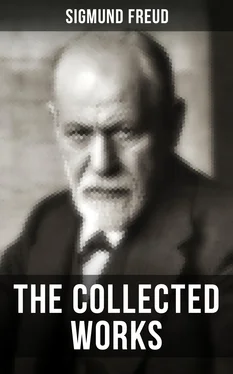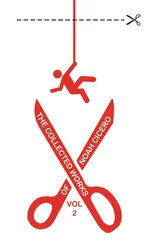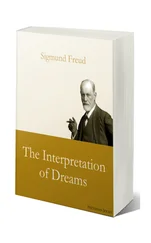We have already spoken of natural scenery as a representation of the female genitals. Mountains and cliffs are symbols of the male organ; the garden a frequent symbol of the female genitals. Fruit does not stand for the child, but for the breasts. Wild animals signify sensually aroused persons, or further, base impulses, passions. Blossoms and flowers represent the female genitals, or more particularly, virginity. Do not forget that the blossoms are really the genitals of the plants.
We already know the room as a symbol. The representation may be extended in that the windows, entrances and exits of the room take on the meaning of the body openings. Whether the room is open or closed is a part of this symbolism, and the key that opens it is an unmistakable male symbol.
This is the material of dream symbolism. It is not complete and might be deepened as well as extended. But I am of the opinion it will seem more than enough to you, perhaps will make you reluctant. You will ask, “Do I really live in the midst of sex symbols? Are all the objects that surround me, all the clothes I put on, all the things that I touch, always sex symbols, and nothing else?” There really are sufficient grounds for such questions, and the first is, “Where, in fact, are we to find the meaning of these dream symbols if the dreamer himself can give no information concerning them, or at best can give only incomplete information?”
My answer is: “From many widely different sources, from fairy tales and myths, jokes and farces, from folklore, that is, the knowledge of the customs, usages, sayings and songs of peoples, from the poetic and vulgar language. Everywhere we find the same symbolism and in many of these instances we understand them without further information. If we follow up each of these sources separately we shall find so many parallels to the dream symbolism that we must believe in the correctness of our interpretations.”
The human body, we have said, is, according to Scherner, frequently symbolized in the dream by the house. Continuing this representation, the windows, doors and entrances are the entrances into the body cavities, the facades are smooth or provided with balconies and projections to which to hold. The same symbolism is to be found in our daily speech when we greet a good friend as “ old house ” or when we say of someone, “We’ll hit him in the belfry ,” or maintain of another that he’s not quite right in the upper story . In anatomy the body openings are sometimes called the body-portals .
The fact that we meet our parents in the dream as imperial or royal persons is at first surprising. But it has its parallel in the fairy tale. Doesn’t it begin to dawn upon us that the many fairy tales which begin “Once upon a time there was a king and a queen ” intend nothing else than, “Once there was a father and a mother ?” In our families we refer to our children as princes , the eldest as the crown-prince . The king usually calls himself the father of the country . We playfully designate little children as worms , and say, sympathetically, “ poor little worm .”
Let us return to the symbolism of the house. When we use the projections of the house to hold ourselves on to in the dream, are we not reminded of the familiar colloquialism about persons with well-developed breasts: “She has something to hold onto ”? The folk express this in still another way when it says, “there’s lots of wood in front of her house ”; as though it wished to come to the aid of our interpretation that wood is a feminine, maternal symbol.
In addition to wood there are others. We might not understand how this material has come to be a substitute for the maternal, the feminine. Here our comparison of languages may be helpful. The German word Holz (wood) is said to be from the same stem as the Greek word, nlê, which means stuff, raw material. This is an example of the case, not entirely unusual, where a general word for material finally is exclusively used for some special material. There is an island in the ocean, known by the name of Madeira. The Portuguese gave it this name at the time of its discovery because it was at that time entirely covered with forests, for in the language of the Portuguese, Madeira means wood . You will recognize, however, that Madeira, is nothing else than the slightly changed Latin word materia which again has the general meaning of material Material is derived from mater , mother. The material out of which something is made, is at the same time its mother-part. In the symbolic use of wood for woman, mother, this ancient conception still lives.
Birth is regularly expressed in dreams by some connection with water; one plunges into the water, or comes out of the water, which means one gives birth to, or is born. Now let us not forget that this symbol may refer in two ways to the truths of evolutionary history. Not alone have all land-mammals, including the ancestors of man, developed out of water animals — this is the ultimate fact — but every single mammal, every human being, lived the first part of his existence in the water — namely, lived in the body of his mother as an embryo in the amniotic fluid and came out of the water at the time of his birth. I do not wish to maintain that the dreamer knows this, on the contrary I hold that he does not have to know. The dreamer very likely knows some things because of the fact that he was told about them in his childhood, and for that very reason I maintain that this knowledge has played no part in the construction of his symbols. He was told in childhood that the stork brought him — but where did it get him? Out of a lake, out of the well — again, out of the water. One of my patients to whom such information had been given, a little count, disappeared for a whole afternoon. Finally he was discovered lying at the edge of the palace lake, his little face bent above the water and earnestly peering into it to see if he could not see the little children at the bottom.
In the myths of the birth of the hero, which O. Rank submitted to comparative examination — the oldest is that of King Sargon of Agade, about 2800 B.C. — exposure in the water and rescue from water play a predominating role. Rank has recognized that these are representations of birth, analogous to those customary in dreams. When a person in his dream rescues another from the water, the latter becomes his mother, or just plainly mother; in the myth a person who rescues a child out of the water professes herself as the real mother of the child. In a well-known joke the intelligent Jewish boy is asked who was the mother of Moses. He answered without hesitation, the Princess. But no, he is told, she only took him out of the water. “That’s what she says ,” is his reply, and thereby he shows that he has found the correct interpretation of the myth.
Leaving on a trip represents death in the dream. Likewise it is the custom in the nursery when a child asks where someone who has died, and whom he misses, may be, to say to him that the absent one has taken a trip. Again I should like to deny the truth of the belief that the dream symbol originates in this evasion used for the benefit of children. The poet makes use of the same symbol when he speaks of the Hereafter as “that undiscovered bourne from which no traveler returns.” Even in everyday speech it is customary to refer to the last journey. Every person acquainted with ancient rite knows how seriously, for example, the Egyptians considered the portrayal of a journey to the land of the dead. There still exist many copies of the “death book” which was given to the mummy for this journey as a sort of Baedeker. Since the burial places have been separated from the living quarters, the last journey of the dead person has become a reality.
Читать дальше












